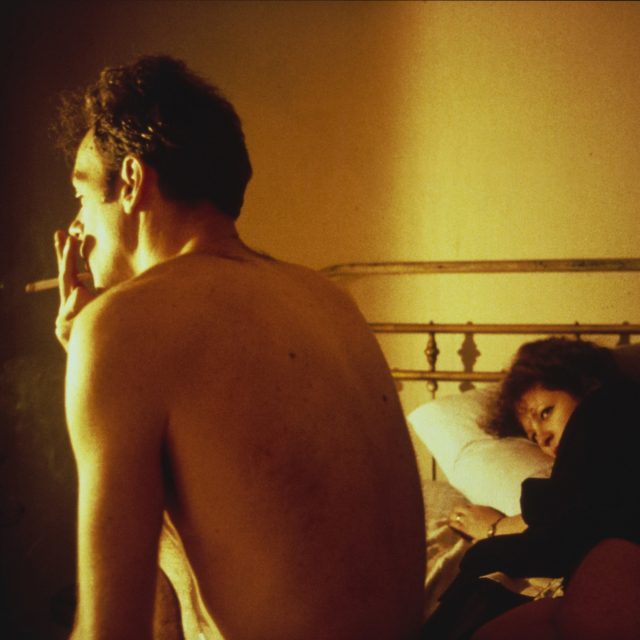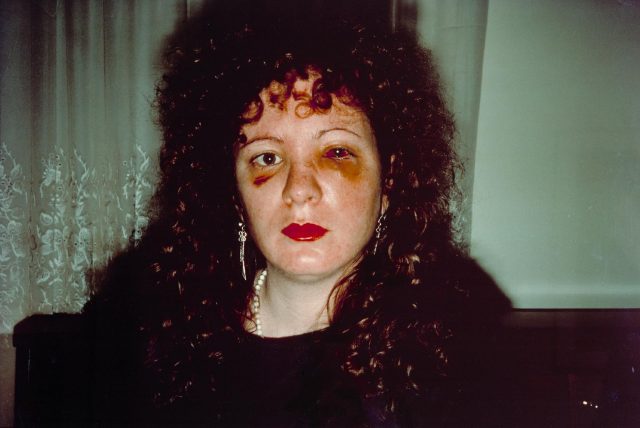
Nan Goldin, “Nan and Brian in Bed, New York City,” silver dye bleach print, 1983, printed 2006 (the Museum of Modern Art, New York. Acquired through the generosity of Jon L. Stryker. © 2016 Nan Goldin)
Museum of Modern Art
11 West 53rd St. between Fifth & Sixth Aves.
Wednesday, February 8, free with museum admission, 11:30 am
Exhibition continues through April 16, $14-$25
212-708-9400
www.moma.org
“The Ballad of Sexual Dependency is the diary I let people read. My written diaries are private; they form a closed document of my world and allow me the distance to analyze it. My visual diary is public,” Nan Goldin wrote about her seminal 1985-86 multimedia exhibition and book. “There is a popular notion that the photographer is by nature a voyeur, the last one invited to the party. But I’m not crashing; this is my party. This is my family, my history.” Goldin and the Museum of Modern Art are currently inviting everyone to the party, showing The Ballad of Sexual Dependency in its complete audiovisual form through April 16. Consisting of nearly seven hundred portraits set to music by James Brown, Maria Callas, the Velvet Underground, Nina Simone, and Screamin’ Jay Hawkins, Ballad is set primarily amid the heroin subculture of downtown New York from 1979 to 1986, just as AIDS started ravaging the city, as well as in Berlin, Paris, Boston, Provincetown, and Mexico. Born in Washington, DC, in 1953, Goldin, who left home when she was just fourteen, took intimate photos of her chosen family — friends, lovers, junkies, drag queens, and others, including artists Greer Lankton and Vivienne Dick, actress and writer Cookie Mueller, Andy Warhol, Jim Jarmusch, and performer Suzanne Fletcher. Deeply affected by her sister Barbara’s suicide — she killed herself in 1964 at the age of eighteen, when Nan was eleven — Goldin sees the photos as a way to hold on to her memories. The photos are not chic glamour shots but instead captured moments of real life, with natural lighting and what would technically be considered imperfect composition. Yet they have an immediacy and emotion that overstaging and multiple takes would ruin. Although reminiscent of the work of Larry Clark and Diane Arbus, Ballad finds Goldin boldly revealing her life, particularly in two of the most famous shots, one of her boyfriend Brian sitting on the edge of a bed, smoking a cigarette, as sunlight pours in over Goldin’s face on a pillow, her eyes slyly looking at him, while in the other, a horribly beaten Goldin — the culprit was Brian —looks into the camera, her left eye nearly swollen shut, her red lipstick, dangling earrings, and pearl necklace defining her feminism and strength.

Nan Goldin, “Nan One Month After Being Battered,” silver dye bleach print, 1984, printed 2008 (the Museum of Modern Art, New York. Purchase)
On February 8 at 11:30 am, independent educator Diana Bush will lead a Gallery Session at MoMA, “Nan Goldin: The Personal Is Political,” exploring the relationship between photography, memory, and diary, elements that are central to Goldin’s entire oeuvre, which also includes such books and series as “I’ll Be Your Mirror” and “The Devil’s Playground.” (You can find out more about Goldin in Sabine Lidl’s 2013 documentary, Nan Goldin — I Remember Your Face.) Named after a song in Kurt Weill and Bertolt Brecht’s 1928 classic, The Threepenny Opera (“They’re all the same / In meeting love’s confusion / Poor noble souls / Get blotted in illusion”) — The Ballad of Sexual Dependency is in its own viewing room at MoMA, where visitors feel like guests at this decades-old party, watching photos of acquaintances pass by, each one a not-so-distant memory tinged with joy and sadness. The central slide show is supplemented by numerous posters from the early versions of Ballad as well as silver dye bleach prints of more than a dozen of the photos, including “The Parents’ Wedding Photo, Swampscott, Massachusetts,” “Trixie on the Cot, New York City,” “Nan One Month After Being Battered,” and “Philippe H. and Suzanne Kissing at Euthanasia, New York City.” Goldin also wrote in the Ballad book, “The diary is my form of control over my life. It allows me to obsessively record every detail. It enables me to remember.” Extended through April 16, The Ballad of Sexual Dependency is hard to forget.